-
 Artist: Utagawa Kunisada [歌川 国貞] a.k.a. Utagawa Toyokuni III [三代歌川豊国] (Japanese, 1786 – 1865). Block cutter: Horikō (Kiyomizu) Ryūzō [彫工 柳三]. Publisher: Ebisuya Shoshichi [恵比寿屋庄七], Kinshōdō (Japanese, fl. c. 1846 – 1883). Actor Morita Kan'ya XI as Saito Tarozaemon Toshiyuki (Morito Kan'ya, Saito Tarozaemon Toshiyuki) Signed Toyokuni ga within the artist's Toshidama cartouche, publisher's seal Sho, Kinshodo, carver's seal Horiko Ryusan, censor's seal aratame with date 1860, 3rd month. Date: 3/1860. Oban tate-e; 36.5 x 25.3 cm. The actor Morita Kan'ya XI (1802-1863) is in the role of Saito Tarozaemon Toshiyuki from the play Oto no Miya Asahi no Yoroi (Oto no Miyo and the Armor of the Rising Sun). The play picks up following the Genko War of 1331-33 in which Emperor Go-Daigo (1288-1339) led a failed uprising against the ruling Hojo clan. Tarozaemon was a Hojo warlord and is credited with much of the victory. After the conflict, his lord Norisada receives a summer festival lantern from the courtesan Sanmi-no-Tsubone, which bears a riddling inscription. He and Tarozaemon deliberate over the courtesan and her message for quite some time until they realize that she is attempting to manipulate Norisada in the hopes of returning the Emperor from exile. Following this revelation, Norisada reinterprets the message to mean kiriko, literally "to cut a child," and determines that Sanmi-no-Tsubone's son must be killed. He instructs Tarozaemon to do the deed. However, unbeknownst to Norisada and in spite of his allegiance to the Hojo clan, Tarozaemon is sympathetic to Sanmi-no-Tsubone and her son. At one time, his own daughter had served in the Imperial Palace and was spared execution only through Sanmi-no-Tsubone's intervention. As repayment of that debt, he kills his own grandson in the other boy's stead and returns to Norisada to report that he had accomplished the mission. This print is from a series of portraits that Kunisada undertook very late in life and has been named Kinshodo-ban yakusha okubi-e (Kinshodo's Large-Head Actor Portraits) in reference to the publisher, Ebisuya Shochochi of Kinshodo. The series depicted great actors from the past and present in their famous roles. Kunisada was guided by images from his own oeuvre: he recorded Kan'ya in this role in the 8th month of 1829. As this was meant to be Kunisada's grandest actor series, it was executed on thick paper with the best possible pigments and the highest level of craftsmanship. In this unusual frontal portrait, Kunisada presents Morita Kan'ya XI as the loyal Tarozaemon with his eyes rolling upward and his jaw set in grim determination to commit the unthinkable act in an ultimate display of samurai honour. Text by Scholten Japanese Art, New York. Ref.: Waseda University Theatre Museum (enpaku.waseda.ac.jp), accession no. 100-5261 (for 1829 portrait of the same); [LIB-1212.2017] Robert Schaap. Kunisada: Imaging, drama and beauty. — Leiden: Hotei Publishing, 2016, p. 165 (№ 16). Andreas Marks. Publishers of Japanese woodblock prints: A compendium. Ebisuya Shoshichi (1846-83) - P6032.
Artist: Utagawa Kunisada [歌川 国貞] a.k.a. Utagawa Toyokuni III [三代歌川豊国] (Japanese, 1786 – 1865). Block cutter: Horikō (Kiyomizu) Ryūzō [彫工 柳三]. Publisher: Ebisuya Shoshichi [恵比寿屋庄七], Kinshōdō (Japanese, fl. c. 1846 – 1883). Actor Morita Kan'ya XI as Saito Tarozaemon Toshiyuki (Morito Kan'ya, Saito Tarozaemon Toshiyuki) Signed Toyokuni ga within the artist's Toshidama cartouche, publisher's seal Sho, Kinshodo, carver's seal Horiko Ryusan, censor's seal aratame with date 1860, 3rd month. Date: 3/1860. Oban tate-e; 36.5 x 25.3 cm. The actor Morita Kan'ya XI (1802-1863) is in the role of Saito Tarozaemon Toshiyuki from the play Oto no Miya Asahi no Yoroi (Oto no Miyo and the Armor of the Rising Sun). The play picks up following the Genko War of 1331-33 in which Emperor Go-Daigo (1288-1339) led a failed uprising against the ruling Hojo clan. Tarozaemon was a Hojo warlord and is credited with much of the victory. After the conflict, his lord Norisada receives a summer festival lantern from the courtesan Sanmi-no-Tsubone, which bears a riddling inscription. He and Tarozaemon deliberate over the courtesan and her message for quite some time until they realize that she is attempting to manipulate Norisada in the hopes of returning the Emperor from exile. Following this revelation, Norisada reinterprets the message to mean kiriko, literally "to cut a child," and determines that Sanmi-no-Tsubone's son must be killed. He instructs Tarozaemon to do the deed. However, unbeknownst to Norisada and in spite of his allegiance to the Hojo clan, Tarozaemon is sympathetic to Sanmi-no-Tsubone and her son. At one time, his own daughter had served in the Imperial Palace and was spared execution only through Sanmi-no-Tsubone's intervention. As repayment of that debt, he kills his own grandson in the other boy's stead and returns to Norisada to report that he had accomplished the mission. This print is from a series of portraits that Kunisada undertook very late in life and has been named Kinshodo-ban yakusha okubi-e (Kinshodo's Large-Head Actor Portraits) in reference to the publisher, Ebisuya Shochochi of Kinshodo. The series depicted great actors from the past and present in their famous roles. Kunisada was guided by images from his own oeuvre: he recorded Kan'ya in this role in the 8th month of 1829. As this was meant to be Kunisada's grandest actor series, it was executed on thick paper with the best possible pigments and the highest level of craftsmanship. In this unusual frontal portrait, Kunisada presents Morita Kan'ya XI as the loyal Tarozaemon with his eyes rolling upward and his jaw set in grim determination to commit the unthinkable act in an ultimate display of samurai honour. Text by Scholten Japanese Art, New York. Ref.: Waseda University Theatre Museum (enpaku.waseda.ac.jp), accession no. 100-5261 (for 1829 portrait of the same); [LIB-1212.2017] Robert Schaap. Kunisada: Imaging, drama and beauty. — Leiden: Hotei Publishing, 2016, p. 165 (№ 16). Andreas Marks. Publishers of Japanese woodblock prints: A compendium. Ebisuya Shoshichi (1846-83) - P6032. -
 Artist: Utagawa Kuniyoshi [歌川 國芳] (Japanese, 1798 – 1861).
Artist: Utagawa Kuniyoshi [歌川 國芳] (Japanese, 1798 – 1861).Title: Suzume fukube [美人団扇絵] (Sparrow and gourds).
Series: Kacho awase [花鳥合] (Collection of flowers and birds).
Publisher: Aritaya Seiemon [有田屋 清右衛門] (Japanese, fl. c. 1830 – 1862); Seal: Marks 17-011 | 014d.Signed: Ichiyosai Kuniyoshi ga in a red cartouche and sealed with paulownia crest (kiri mon).
Size: Uchiwa-e (untrimmed fan print) 296 x 230 mm.
Double nanushi censor seals: Kinugasa & Watanabe, Kaei 2-3 (1849–50).
Ref.: Kuniyoshi Project. -
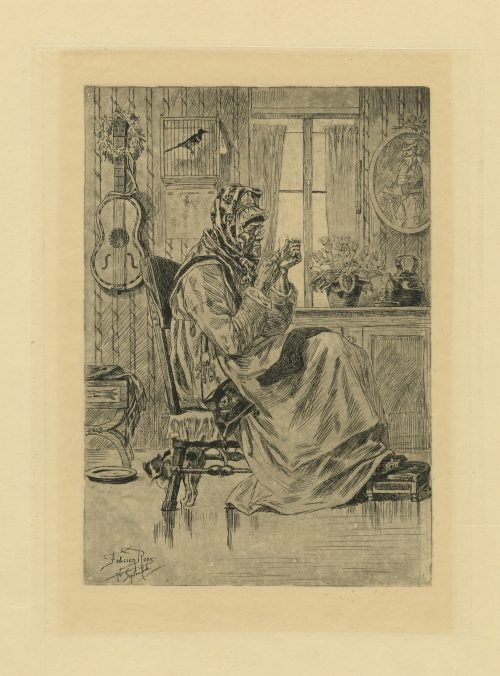
Etching on wove paper, depicting an old woman trying to thread a needle. Signed in plate: "Felicien Rops, 76 Septembre". Owner's stamp LvM on verso.
Dimensions: Paper: 51.9 x 35 cm; Plate: 27.5 x 21 cm; Image: 23.5 x 16 cm.
Catalogue raisonné: Arthur Hubschmid (1977): 358; Graphics irreverent and erotic (1968): 54.
-
 An uncut fan print showing a young woman checking her makeup in a mirror from the series The pride of Edo [江戸じまん] (Edo jiman). The head portrait in the red circle is of kabuki actor Danjūrō VII. Ichikawa Danjūrō VII [市川団十郎] (Japanese, 1791 – 1859); other names: Ichikawa Ebizō V, Ichikawa Hakuen II, Ichikawa Shinnosuke I. Artist: Utagawa Kunisada [歌川 国貞] a.k.a. Utagawa Toyokuni III [三代 歌川 豊国] (Japanese, 1786 – 1865). Publisher: Ibaya Kyūbei [伊場屋 久兵衛] (Japanese, fl. 1804 – 1851). Artists signature: Ōkō Kunisada ga [應好国貞画] (Drawn to satisfy the taste of Kunisada) Publisher’s seal:久 – Ibakyū [伊場久]. Censor's seal: Kiwame; date seal: Bunsei 10 (1827). Saze: Aiban uchiwa-e; 23.2 x 28.9 cm. Ref.: [LIB-2967.2022] Utagawa Kunisada (1786 – 1865): His world revisited / Catalogue № 17, Exhibition March 17-21, 2021. — NY: Sebastian Izzard, LLC., 2021; p. 102, Cat. 28–fig. a.
An uncut fan print showing a young woman checking her makeup in a mirror from the series The pride of Edo [江戸じまん] (Edo jiman). The head portrait in the red circle is of kabuki actor Danjūrō VII. Ichikawa Danjūrō VII [市川団十郎] (Japanese, 1791 – 1859); other names: Ichikawa Ebizō V, Ichikawa Hakuen II, Ichikawa Shinnosuke I. Artist: Utagawa Kunisada [歌川 国貞] a.k.a. Utagawa Toyokuni III [三代 歌川 豊国] (Japanese, 1786 – 1865). Publisher: Ibaya Kyūbei [伊場屋 久兵衛] (Japanese, fl. 1804 – 1851). Artists signature: Ōkō Kunisada ga [應好国貞画] (Drawn to satisfy the taste of Kunisada) Publisher’s seal:久 – Ibakyū [伊場久]. Censor's seal: Kiwame; date seal: Bunsei 10 (1827). Saze: Aiban uchiwa-e; 23.2 x 28.9 cm. Ref.: [LIB-2967.2022] Utagawa Kunisada (1786 – 1865): His world revisited / Catalogue № 17, Exhibition March 17-21, 2021. — NY: Sebastian Izzard, LLC., 2021; p. 102, Cat. 28–fig. a. -
 Artist: Utagawa Kunisada [歌川 国貞] a.k.a. Utagawa Toyokuni III [三代歌川豊国] (Japanese, 1786 – 1865). Signed: Ichiyōsai Toyokuni hitsu [一陽斎豊国筆]. Inscriptions: [松竹梅] Shochikubai = pine (matsu, 松), bamboo (take, 竹), and plum (ume, 梅) – an auspicious grouping known as “The Three Friends of Winter“; [三福追] (Sanpuku tsui) – the three delights, or pleasures. Date seal and aratame censor seal: Ansei 2, 1st month (1855). Publisher: Ibaya Senzaburō [伊場屋仙三郎] (Japanese, c. 1815 – 1869). Block carver: Yokokawa Takejirō [横川竹二郎] (Japanese, fl. 1845 – 1863); seal: Hori Take [彫竹]. Kabuki actor Onoe Kikugorō V [五代目尾上菊五郎] (Onoe Baikō V, Ichimura Kakitsu IV, Ichimura Uzaemon XIII, Ichimura Kurōemon, Japanese, 1844 – 1903) giving candies to the memorial portrait of his predecessor, Ichimura Takenojō V [市村竹之丞] (Ichimura Uzaemon XII, Ichimura Kamenosuke, Ichimura Toyomatsu, Japanese, 1812 – 1851); the latter is dressed in a green robe adorned with a crest (mon) of a kōrin-style crane in a tortoiseshell (octagon), the hanging scroll border decorated with bamboo under snow; the collar of Onoe's kimono decorated with plum blossoms, another plum blossom arrangement decorates the screen behind him. Actors identified by Horst Graebner. Two fan prints from this series in Varshavsky Collection:
Artist: Utagawa Kunisada [歌川 国貞] a.k.a. Utagawa Toyokuni III [三代歌川豊国] (Japanese, 1786 – 1865). Signed: Ichiyōsai Toyokuni hitsu [一陽斎豊国筆]. Inscriptions: [松竹梅] Shochikubai = pine (matsu, 松), bamboo (take, 竹), and plum (ume, 梅) – an auspicious grouping known as “The Three Friends of Winter“; [三福追] (Sanpuku tsui) – the three delights, or pleasures. Date seal and aratame censor seal: Ansei 2, 1st month (1855). Publisher: Ibaya Senzaburō [伊場屋仙三郎] (Japanese, c. 1815 – 1869). Block carver: Yokokawa Takejirō [横川竹二郎] (Japanese, fl. 1845 – 1863); seal: Hori Take [彫竹]. Kabuki actor Onoe Kikugorō V [五代目尾上菊五郎] (Onoe Baikō V, Ichimura Kakitsu IV, Ichimura Uzaemon XIII, Ichimura Kurōemon, Japanese, 1844 – 1903) giving candies to the memorial portrait of his predecessor, Ichimura Takenojō V [市村竹之丞] (Ichimura Uzaemon XII, Ichimura Kamenosuke, Ichimura Toyomatsu, Japanese, 1812 – 1851); the latter is dressed in a green robe adorned with a crest (mon) of a kōrin-style crane in a tortoiseshell (octagon), the hanging scroll border decorated with bamboo under snow; the collar of Onoe's kimono decorated with plum blossoms, another plum blossom arrangement decorates the screen behind him. Actors identified by Horst Graebner. Two fan prints from this series in Varshavsky Collection:
SVJP-0335.2021
-
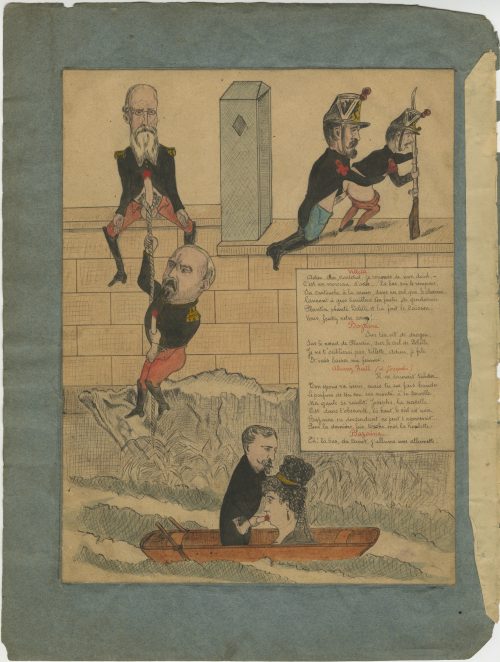 A series of seven political caricatures with indecent content, ink and pigment on paper, bound in a grey-blue folder. Each drawing is pasted to a grey-blue sheet of paper 32 x 24 cm. PLATES: 1) Villette; Bazaine; Alvarez Rull: 250 x 192 mm
A series of seven political caricatures with indecent content, ink and pigment on paper, bound in a grey-blue folder. Each drawing is pasted to a grey-blue sheet of paper 32 x 24 cm. PLATES: 1) Villette; Bazaine; Alvarez Rull: 250 x 192 mm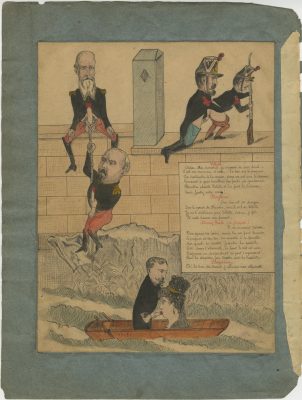
Villette Adieu, cher maréchal, je réponds de mon dard C’est un morceau d’acier… Là bas, sur le rempart, Sa cartouche à la main, dans un cul qui le charme, Lançant à gros bouillons son foutre de gendarme Plantin plante Delille et lui font le Caisson. Bazaine Sur ton vit de dragon Sur le nœud de Plantin, sur le cul de Delille, Je ne t’oublierai pas, Villette, adieu, je file Et je vais baiser ma femme. Alvarez Rull (à Josépha) Il ne saurait tarder, Ton epoux va venir, mais tu me fais bander, Le parfum de ton con me monte à la cervelle, Ma gaule se raidit . Josépha, la nacelle Est dans l’ obscurité, là haut, le ciel est noir, Bazaine en descendant ne peut t’ apercevoir … Pour la dernière fois, torche moi la houlette. Bazaine Eh ! là bas, du canot, j’allume une allumette!
Villette Farewell, dear Marshal, I vouch for my dick. It’s like a steel rod … Over there, on the ramparts, Plantin, his dick in hand, pounds Delisle’s beckoning ass And fills it with his bubbling gendarme’s cum. Bazaine For your dragoon’s dick, For Plantin's prick, for Delisle's ass, I won't forget you, Villette, goodbye, I'm leaving And I'm going to fuck my wife. Alvarez Rull (to Josépha) Hurry up, Your husband is coming, but I got a hard on you, The scent of your cunt penetrates my brain, My rod stiffened. Josépha, the gondola Is in the dark, the sky is black, Bazaine coming down and cannot see you... Give me one last blowjob.Bazaine Hey! Over there, from the canoe, I light a match!
French marshal Achille Bazaine capitulated to Bismarck during the Franco-Prussian war on 27 October 1870. In 1873, he was tried for treason and received a death sentence, later commuted to 20 years' imprisonment. Bazaine was incarcerated in the Fort Royal on Île Sainte-Marguerite, from which he escaped on August 9–10, 1874, with the help of Colonel Villette [Willette], his wife Josefa [Pepita Peña], and her nephew Alvarez Rull. They sailed to Genoa in Italy and from there to London. Plantin and Delisle were prison guards. The story was described in detail during the Trial of Col. Villette and his Accomplices in 1874 and published later in Robert Christophe. La Vie tragique du maréchal Bazaine. — Paris: Vautrain Jacques, 1947.
2) Impératrice Eugénie: 218 x 165 mm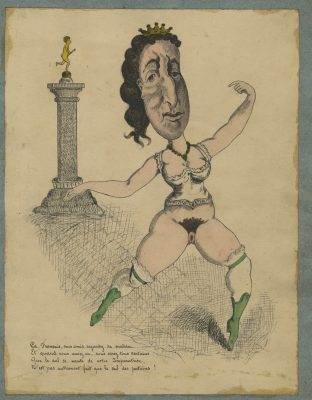
Ça, Français, mes amis, regardez sa matrice, Et quand vous aurez vu, vous serez tous certains Que le cul si vanté de votre Impératrice, N’est pas autrement fait que le cul des putains!
That, French, my friends, look at her cunt, And when you have seen, you will all be certain That the so acclaimed ass of your Empress, Is no different than the ass of whores! 3) Napoléon III: 215 x 168 mm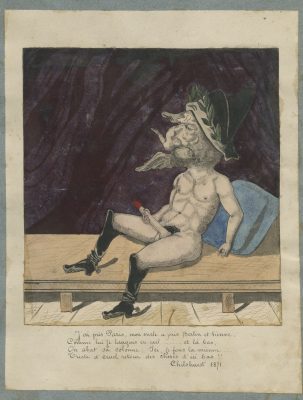
J’ai pris Paris, mon oncle a pris Berlin et Vienne. Comme lui je languis en exil …… et là bas, On abat sa colonne; Ici, je fous la mienne…. Triste et cruel retour des choses d’ici bas!! Chilshurst 1871. [i.e. Chislehurst]
I took Paris, my uncle took Berlin and Vienna. Like him, I, too, languish in exile. His column there was demolished; I’m jerking mine off here…. Cruel and sorrowful deeds!! 4) La confession: 216 x 168 mm (Georges Darboy?)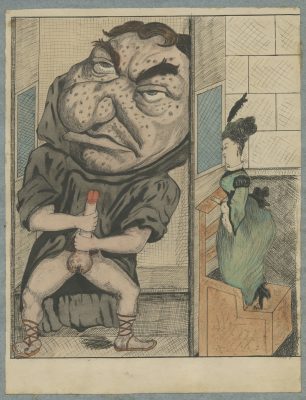 5) Napoléon III et Thérèsa (chanteuse Désirée Emma Valladon): 216 x 176 mm
5) Napoléon III et Thérèsa (chanteuse Désirée Emma Valladon): 216 x 176 mm
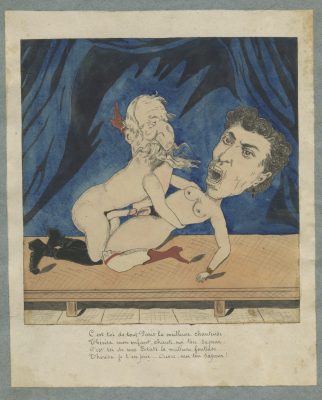
C’est toi de tout Paris la meilleure chanteuse, Thérèsa mon enfant, chante-moi ton sapeur. C’est toi de mes Etats la meilleure fonteuse.. Thérèsa je t’en prie … Ouvre-moi ton sapeur!
You, the best singer in all of Paris, Teresa, my child, sing for me where to insert. You are the best padding in my entire country… Teresa, please... Open your slit for me! 6) Thiers: 219 x 168 mm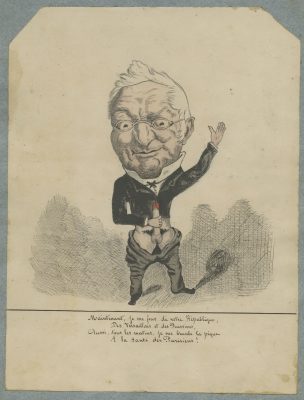
Maintenant, je me fous de votre République, Des Versaillais et des Prussiens, Aussi, tous les matins, je me branle la pique A la santé des Parisiens!
Yes, I don’t care about your Republic now, About Versailles and the Prussians, And every morning I jerk off For the health of Parisians! 7) Émile Ollivier/Rochefort/Jules Favre/Gambetta : 212 x 168 mm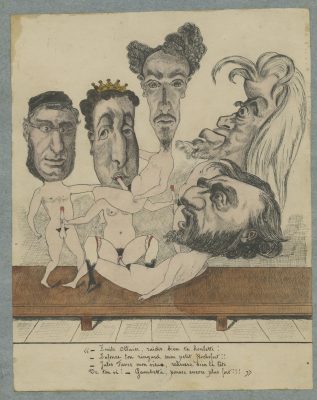
« — Emile Ollivier, raidis bien la houlette! — Enfonce ton ringard mon petit Rochefort!! — Jules Favre mon vieux, redresse bien la tête De ton vi! — Gambetta, pousse encore plus fort!!! »
Emile Ollivier, tighten your dick! - Stick in your poker, my little Rochefort!! - Jules Favre, old man, straighten your dickhead Damn it! – Gambetta, push even harder!!!Characters: Bazaine, François Achille (French, 1811 – 1888) Darboy, Georges (French, 1813 – 1871) Favre, Jules (French, 1809 – 1880) Gambetta, Léon (French, 1838 – 1882) Montijo, Eugénie de (Spanish-French, 1826 – 1920) Napoleon III [Bonaparte, Charles-Louis Napoléon] (French, 1808 – 1873) Ollivier, Émile (French, 1825 – 1913) Peña Azcárate, Josefa [Peña, Pepita] (Mexican-French, 1847 – 1900); Alvarez Rull – nephew of Josefa Peña Azcárate. Rochefort, Henri (French, 1831 – 1913) Thérésa [Valladon, Désirée Emma] (French, 1836 – 1913) Thiers, Adolphe (French, 1797 – 1877)
-
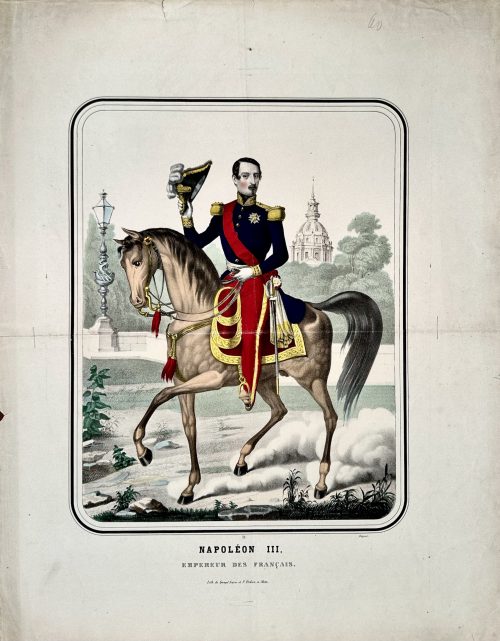 Hand-coloured chromolithography on wove paper, 600 x 470 mm; black ink stamp “4921” to reverse, horizontal and vertical centrefolds. Image of Napoléon III on horseback, in a frame; lettering under the frame: 34 — Déposé | NAPOLÉON III | EMPEREUR DES FRANÇAIS. | Lith. de Gangel frères et P. Didion, à Metz. || Gangel frères et P. Didion (Metz) – printer/publisher. Paulin Didion (French, 1831 – 1879)
Hand-coloured chromolithography on wove paper, 600 x 470 mm; black ink stamp “4921” to reverse, horizontal and vertical centrefolds. Image of Napoléon III on horseback, in a frame; lettering under the frame: 34 — Déposé | NAPOLÉON III | EMPEREUR DES FRANÇAIS. | Lith. de Gangel frères et P. Didion, à Metz. || Gangel frères et P. Didion (Metz) – printer/publisher. Paulin Didion (French, 1831 – 1879) -

-
 Artist: Utagawa Kunisada [歌川 国貞] a.k.a. Utagawa Toyokuni III [三代 歌川 豊国] (Japanese, 1786 – 1865). An untrimmed fan print titled Fuji Tsukuba aiaigasa, shows the actors Ichikawa Ebizo V [市川海老蔵] and the onnagata actor Iwai Shijaku I [岩井紫若] sharing an umbrella against the wind. Tsukuba, about 50 kilometres from Edo, was an area where both Fuji and Mount Tsukuba could be viewed together. Mount Fuji being the female and Mount Tsukuba the male. An aizuri-e background (common to all the designs in this set). A play on images and words. Actors: Ichikawa Danjūrō VII [市川団十郎] (Japanese, 1791 – 1859); other names: Ichikawa Ebizō V [市川海老蔵], Ichikawa Hakuen II, Ichikawa Shinnosuke I. Iwai Matsunosuke I [岩井松之助] (Japanese, 1804 – 1845); other names: Iwai Hanshirō VII, Iwai Shijaku I [岩井紫若], Iwai Komurasaki I. Publisher: Ibaya Senzaburo [伊場屋仙三郎] (Japanese, fl. c. 1845 – 1847). The publisher’s seal is on the umbrella. Date: circa 1832. Signed: Kōchōrō Kunisada ga in a red double-gourd cartouche. From the series of fan prints:
Artist: Utagawa Kunisada [歌川 国貞] a.k.a. Utagawa Toyokuni III [三代 歌川 豊国] (Japanese, 1786 – 1865). An untrimmed fan print titled Fuji Tsukuba aiaigasa, shows the actors Ichikawa Ebizo V [市川海老蔵] and the onnagata actor Iwai Shijaku I [岩井紫若] sharing an umbrella against the wind. Tsukuba, about 50 kilometres from Edo, was an area where both Fuji and Mount Tsukuba could be viewed together. Mount Fuji being the female and Mount Tsukuba the male. An aizuri-e background (common to all the designs in this set). A play on images and words. Actors: Ichikawa Danjūrō VII [市川団十郎] (Japanese, 1791 – 1859); other names: Ichikawa Ebizō V [市川海老蔵], Ichikawa Hakuen II, Ichikawa Shinnosuke I. Iwai Matsunosuke I [岩井松之助] (Japanese, 1804 – 1845); other names: Iwai Hanshirō VII, Iwai Shijaku I [岩井紫若], Iwai Komurasaki I. Publisher: Ibaya Senzaburo [伊場屋仙三郎] (Japanese, fl. c. 1845 – 1847). The publisher’s seal is on the umbrella. Date: circa 1832. Signed: Kōchōrō Kunisada ga in a red double-gourd cartouche. From the series of fan prints:
Two more prints from the series 'Fuji and Tsukuba sharing an umbrella' (Fuji Tsukuba aiaigasa), not in this Collection:
SVJP-0341.2021

Kabuki actors Onoe Kikugorō III and Iwai Kumesaburo II. Year: c. 1832; Publisher: No seal; Signed: Kōchōrō Kunisada ga From Kunisada Project. 
Kabuki actors Bandō Minosuke II and Iwai Shijaku I. Year: c. 1832; Publisher: No seal; Signed: Kōchōrō Kunisada ga From Kunisada Project. -
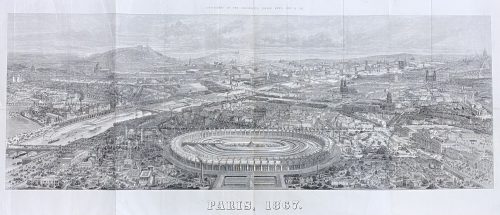
Lithography on paper by Charles Fichot (French, 1817 – 1903), published in a supplement to the Illustrated London News of July 6, 1867.
The construction on the foreground is the International Exposition of 1867 (Exposition universelle d'art et d'industrie de 1867). Dimensions: Sheet: 130 x 58 cm; Image: 118 x 43 cm. -
 The left sheet of (optional) triptych: Geisha of the Shimanouchi district: Actor Nakamura Utaemon III as Danshichi no Mohei, from Three Pleasures of Present-day Osaka (Tōsei Naniwa no sankō)「当世浪花の三興 島之内」 「団七の茂兵衛」 三代目中村歌右衛門. Publisher: Iseya Rihei [伊勢屋利兵衛] (Japanese, fl. 1790s – c. 1879) Year: 1821 (Bunsei 4). Size: Vertical ōban; 36.5 x 25.1 cm. Signed: 於浮瀬亭国貞画 – Drawn by Kunisada in Ukabuse (Ukabuse ni oite Kunisada ga). Ukabuse is the name of a famous restaurant in Osaka, this signature can be found only on a three print bijin series [Kunisada Project]. Censor's seal: kiwame 改印:極 Actor Nakamura Utaemon III [中村歌右衛門] (Japanese, 1778 – 1838); other names: Nakamura Tamasuke, Nakamura Baigyoku I, Nakamura Shikan I, Kagaya Fukunosuke I. Character: Danshichi no Mohei [団七茂兵衛]. Ref: MFA ACCESSION NUMBER 11.21936; LIB-2967.2022 Izzard. Full series (triptych) Three Pleasures of Present-day Osaka (Tōsei Naniwa no sankō):
The left sheet of (optional) triptych: Geisha of the Shimanouchi district: Actor Nakamura Utaemon III as Danshichi no Mohei, from Three Pleasures of Present-day Osaka (Tōsei Naniwa no sankō)「当世浪花の三興 島之内」 「団七の茂兵衛」 三代目中村歌右衛門. Publisher: Iseya Rihei [伊勢屋利兵衛] (Japanese, fl. 1790s – c. 1879) Year: 1821 (Bunsei 4). Size: Vertical ōban; 36.5 x 25.1 cm. Signed: 於浮瀬亭国貞画 – Drawn by Kunisada in Ukabuse (Ukabuse ni oite Kunisada ga). Ukabuse is the name of a famous restaurant in Osaka, this signature can be found only on a three print bijin series [Kunisada Project]. Censor's seal: kiwame 改印:極 Actor Nakamura Utaemon III [中村歌右衛門] (Japanese, 1778 – 1838); other names: Nakamura Tamasuke, Nakamura Baigyoku I, Nakamura Shikan I, Kagaya Fukunosuke I. Character: Danshichi no Mohei [団七茂兵衛]. Ref: MFA ACCESSION NUMBER 11.21936; LIB-2967.2022 Izzard. Full series (triptych) Three Pleasures of Present-day Osaka (Tōsei Naniwa no sankō):


-
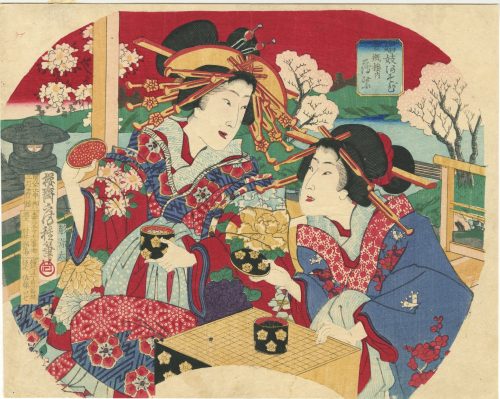 Artist: Utagawa Fusatane [歌川 房種] (Japanese, fl. 1854 – 1889), other names: Ippyosai; Isshosai; Murai Seima; Utagawa Seimas; Osai; Signed: Ōsai Fusatane Hitsu [桜斎房種筆] in a cartouche, with a round stamp. Block carver: Watanabe Yatarō (Japanese, 1850 – 1913); seal [彫弥太] – Hori Yata (Friese 2009b: 117). Publisher [板元] (Hammoto): Satō Ise [佐藤いせ], address: Horiechō, Nichōme, ichi-banchi [堀江町二丁目一番地] Publication date [御届] (otodoke): Meiji 10th year, 3rd month, 22nd day (1877). Artist [画工] (Gakō): Murai Seima [村井 静馬], address: Honjo-Sotodechō, 18 [本所外手丁十八番地]. Uncut fan print (uchiwa-e), 236 x 297 mm, depicting two harlots or courtesans playing [娼妓あそび] (shōgi asobi) go game in the famous Kinpeiro [金瓶楼内] brothel in New Yoshiwara in Tokyo. In the courtesan's name, the second character seems to be 紫 (Murasaki); the first character is unclear, so we do not know her name yet.
Artist: Utagawa Fusatane [歌川 房種] (Japanese, fl. 1854 – 1889), other names: Ippyosai; Isshosai; Murai Seima; Utagawa Seimas; Osai; Signed: Ōsai Fusatane Hitsu [桜斎房種筆] in a cartouche, with a round stamp. Block carver: Watanabe Yatarō (Japanese, 1850 – 1913); seal [彫弥太] – Hori Yata (Friese 2009b: 117). Publisher [板元] (Hammoto): Satō Ise [佐藤いせ], address: Horiechō, Nichōme, ichi-banchi [堀江町二丁目一番地] Publication date [御届] (otodoke): Meiji 10th year, 3rd month, 22nd day (1877). Artist [画工] (Gakō): Murai Seima [村井 静馬], address: Honjo-Sotodechō, 18 [本所外手丁十八番地]. Uncut fan print (uchiwa-e), 236 x 297 mm, depicting two harlots or courtesans playing [娼妓あそび] (shōgi asobi) go game in the famous Kinpeiro [金瓶楼内] brothel in New Yoshiwara in Tokyo. In the courtesan's name, the second character seems to be 紫 (Murasaki); the first character is unclear, so we do not know her name yet. -
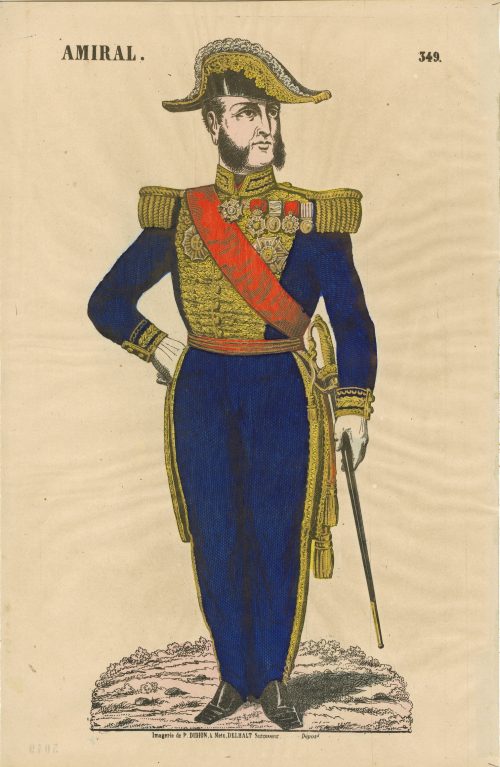 Hand-coloured woodcut on wove paper, 440 x 285 mm; black ink stamp “5049” to reverse. Top left: "AMIRAL"; right: "349". Below: "Imagerie de DIDION, à Metz, DELHALT Successeur." — "Déposé." Paulin Didion (French, 1831 – 1879) – publisher/printer.
Hand-coloured woodcut on wove paper, 440 x 285 mm; black ink stamp “5049” to reverse. Top left: "AMIRAL"; right: "349". Below: "Imagerie de DIDION, à Metz, DELHALT Successeur." — "Déposé." Paulin Didion (French, 1831 – 1879) – publisher/printer. -
 Artist: Utagawa Kunisada [歌川 国貞], a.k.a. Utagawa Toyokuni III [三代 歌川 豊国] (Japanese, 1786 – 1865). Signed: Toyokuni ga [豊国 画] in a red toshidama cartouche Block carver: Yokokawa Takejirō [横川竹二郎] (Japanese, fl. 1845 – 1863), seal: 彫竹 – hori Take. Publisher: Ibaya Senzaburō [伊場屋仙三郎] (Japanese, fl. c. 1845 – 1847). Media: Untrimmed fan print (uchiwa-e), 230 x 295 mm. Combined date seal and kiwame censor seal: Ansei 6 (1859). Title: Princess Sotoori [衣通姫] (Sotoori-hime) – Sotoori-hime was a concubine of Emperor Ingyo (reigned AD 412-53), and one of the Three Gods of Japanese Poetry [和歌三神] (Waka sanjin). Series: Chronicles of Elegant Women [風雅女史傳] (Fūga joshiden). The sign on the torii (Shinto shrine gates) reads: Mountain king shrine [山王宮] – it is the Sannō Shrine at the Nagata Riding Grounds in Edo. A print with these gates is at MFA (Boston) # 21.9853.
Artist: Utagawa Kunisada [歌川 国貞], a.k.a. Utagawa Toyokuni III [三代 歌川 豊国] (Japanese, 1786 – 1865). Signed: Toyokuni ga [豊国 画] in a red toshidama cartouche Block carver: Yokokawa Takejirō [横川竹二郎] (Japanese, fl. 1845 – 1863), seal: 彫竹 – hori Take. Publisher: Ibaya Senzaburō [伊場屋仙三郎] (Japanese, fl. c. 1845 – 1847). Media: Untrimmed fan print (uchiwa-e), 230 x 295 mm. Combined date seal and kiwame censor seal: Ansei 6 (1859). Title: Princess Sotoori [衣通姫] (Sotoori-hime) – Sotoori-hime was a concubine of Emperor Ingyo (reigned AD 412-53), and one of the Three Gods of Japanese Poetry [和歌三神] (Waka sanjin). Series: Chronicles of Elegant Women [風雅女史傳] (Fūga joshiden). The sign on the torii (Shinto shrine gates) reads: Mountain king shrine [山王宮] – it is the Sannō Shrine at the Nagata Riding Grounds in Edo. A print with these gates is at MFA (Boston) # 21.9853. Other prints from the same series in this collection:
SVJP-0343.2021 — Tamagiku:
Other prints from the same series in this collection:
SVJP-0343.2021 — Tamagiku:
 SVJP-0400.2023 — Saiko:
SVJP-0400.2023 — Saiko:
 Note: Special thanks to Horst Graebner, who helped decipher and understand the meaning.
Note: Special thanks to Horst Graebner, who helped decipher and understand the meaning.
-
 Utagawa Kunisada [歌川 国貞] a.k.a. Utagawa Toyokuni III [三代歌川豊国] (Japanese, 1786 – 1865).
Utagawa Kunisada [歌川 国貞] a.k.a. Utagawa Toyokuni III [三代歌川豊国] (Japanese, 1786 – 1865).Uncut fan print (uchiwa-e), 295 x 230 mm, depicting kabuki actor Bandō Shūka I as Shirai Gonpachi (白井権八) reading a scroll by the light of a lantern. From the series A Parody of the Five Chivalrous Commoners; a Cup of Sake From Their Fans (Mitate gonin otoko, go-hiiki no omoizashi). According to Paul Griffith, the term omoizashi refers to the act of pouring a cup of sake for one's chosen partner, here giving an impression of intimacy and affection between famous actors and their patrons.
Actor: Bandō Shūka I [初代坂東しうか] (Japanese, 1813-1855); other names: Bandō Tamasaburō I, Bandō Mitsugorō V (posthumously). The print was probably published by some unknown Yama-Ta (Marks U421b). Double nanushi censor seals and date seal: Muramatsu and Fuku, Kaei 5, 2nd month (2/1852). As Kabuki Encyclopedia put it: "Gonpachi. A parasite. From the character named Shirai Gonpachi who lives at the home of Banzui Chōbei and sponges off him" (An English-Langauge Adaptation of Kabuki Jiten. Samuel L. Leiter. Greenwood Press, 1979, pp. 26, 98-9). There were many kabuki plays based on the story of the lovers Miura-ya Komurasaki and Shirai Gonpachi. (See: [LIB-2226.2019] Algernon Bertram Freeman-Mitford. Tales of Old Japan. — London: Macmillan and Co., 1883). Ref.: Art shop Ezoshi Ukiyoe new collection news, vol. 66, 2023.1 (Jan) # 31, p.8. -
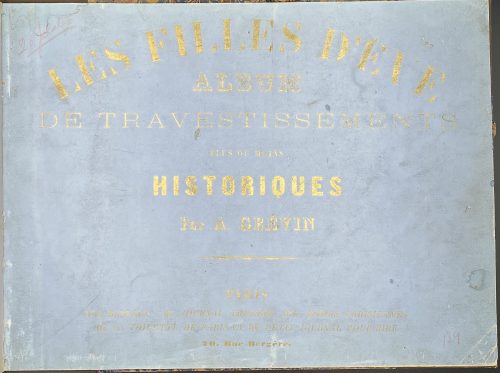 Pictorial album of 20 hand-coloured wood engravings by Firmin Gillot after Alfred Grévin; numbered 1 to 20, bound with tissue guards in half-brown cloth over marbled boards, publisher's gilt-lettered blue wrappers preserved, purple-blueish endpapers. Front wrapper (gilt on blue): LES FILLES D'EVE | ALBUM | DE TRAVESTISSEMENTS | PLUS OU MOINS | HISTORIQUES | Par A. GRÉVIN | — | PARIS | AUX BUREAUX : DU JOURNAL AMUSANT, DES MODES PARISIENNES | DE LA TOILETTE DE PARIS ET DU PETIT JOURNAL POUR RIRE | 20. Rue Bergère. || ; Henri Plon's imprint to back wrapper. Contributors: Grevin, Alfred (French, 1827 – 1892) Gillot, Firmin (French, 1820 – 1872) Plon, Henri (French, 1806 – 1872) Ref.: Metropoliten Museum.
Pictorial album of 20 hand-coloured wood engravings by Firmin Gillot after Alfred Grévin; numbered 1 to 20, bound with tissue guards in half-brown cloth over marbled boards, publisher's gilt-lettered blue wrappers preserved, purple-blueish endpapers. Front wrapper (gilt on blue): LES FILLES D'EVE | ALBUM | DE TRAVESTISSEMENTS | PLUS OU MOINS | HISTORIQUES | Par A. GRÉVIN | — | PARIS | AUX BUREAUX : DU JOURNAL AMUSANT, DES MODES PARISIENNES | DE LA TOILETTE DE PARIS ET DU PETIT JOURNAL POUR RIRE | 20. Rue Bergère. || ; Henri Plon's imprint to back wrapper. Contributors: Grevin, Alfred (French, 1827 – 1892) Gillot, Firmin (French, 1820 – 1872) Plon, Henri (French, 1806 – 1872) Ref.: Metropoliten Museum. -
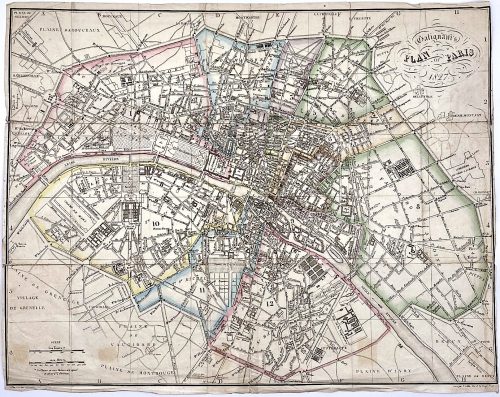 Upper right: Galignani's | PLAN OF PARIS | 1827 || in oval frame: Sauve sculpt. Bottom, under the frame: le Plan écrit par Lallemand. […] Gravé par E. Collin. Rue de la Harpe № 45. Dimensions: 36.5 x 46.5 cm. Armand Joseph Lallemand (French, c. 1810 - 1871) – cartographer. Charles-Étienne Collin (French, 1770 – 1840) – engraver. Étienne Collin II (French,1790 – 1852) – engraver. John Anthony Galignani (Italian, 1796 – 1873) – publisher. William Galignani (Italian, 1798 – 1882) – publisher.
Upper right: Galignani's | PLAN OF PARIS | 1827 || in oval frame: Sauve sculpt. Bottom, under the frame: le Plan écrit par Lallemand. […] Gravé par E. Collin. Rue de la Harpe № 45. Dimensions: 36.5 x 46.5 cm. Armand Joseph Lallemand (French, c. 1810 - 1871) – cartographer. Charles-Étienne Collin (French, 1770 – 1840) – engraver. Étienne Collin II (French,1790 – 1852) – engraver. John Anthony Galignani (Italian, 1796 – 1873) – publisher. William Galignani (Italian, 1798 – 1882) – publisher. -
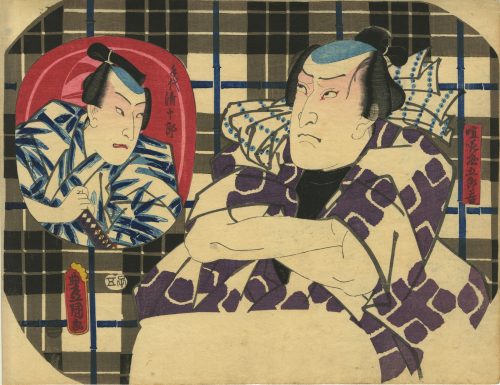 Artist: Utagawa Kunisada [歌川 国貞] a.k.a. Utagawa Toyokuni III [三代歌川豊国] (Japanese, 1786 – 1865). Publisher: Ibaya Senzaburō [伊場屋仙三郎] (Japanese, fl. C. 1845 – 1847). Date seal: [子五] Kaei 5, 5th month (5/1852). Signed: Toyokuni ga [豊国 画] in a red toshidama cartouche. Title: Actor Bandō Takesaburō I as clerk Seijūrō [手代清十郎] (left) and Actor Ichikawa Kodanji IV as Kenkaya Gorōkichi [喧嘩屋五郎吉] (right) in the play Musume ōgi tsui no tatehiki [娘扇一対侠贔屓 (むすめおうぎついのたてひき)] performed at the Nakamura theatre [中村座], in Edo (Tokyo). The playbill for this performance can be found at MFA (Boston) # 11.28042, 11.28285, 11.28286:
Artist: Utagawa Kunisada [歌川 国貞] a.k.a. Utagawa Toyokuni III [三代歌川豊国] (Japanese, 1786 – 1865). Publisher: Ibaya Senzaburō [伊場屋仙三郎] (Japanese, fl. C. 1845 – 1847). Date seal: [子五] Kaei 5, 5th month (5/1852). Signed: Toyokuni ga [豊国 画] in a red toshidama cartouche. Title: Actor Bandō Takesaburō I as clerk Seijūrō [手代清十郎] (left) and Actor Ichikawa Kodanji IV as Kenkaya Gorōkichi [喧嘩屋五郎吉] (right) in the play Musume ōgi tsui no tatehiki [娘扇一対侠贔屓 (むすめおうぎついのたてひき)] performed at the Nakamura theatre [中村座], in Edo (Tokyo). The playbill for this performance can be found at MFA (Boston) # 11.28042, 11.28285, 11.28286: Actors:
Bandō Takesaburō I (初代坂東竹三郎) (Japanese, 1832 – 1877); other names: Shinshi, Shinsui V, Bandō Hikosaburō V [五代目坂東彦三郎], Bandō Tsurunosuke I.
Ichikawa Kodanji IV [市川小團次] (Japanese, 1812 – 1866); other names: Ichikawa Yonejūrō I, Ichikawa Yonezō III, Ichikawa Eizō.
Actors:
Bandō Takesaburō I (初代坂東竹三郎) (Japanese, 1832 – 1877); other names: Shinshi, Shinsui V, Bandō Hikosaburō V [五代目坂東彦三郎], Bandō Tsurunosuke I.
Ichikawa Kodanji IV [市川小團次] (Japanese, 1812 – 1866); other names: Ichikawa Yonejūrō I, Ichikawa Yonezō III, Ichikawa Eizō.
Similar images were then used for the series Seven flourishing plants on lanterns for summer evenings [涼調珍盛の七草] (Suzumi chōchin sakari no nanakusa) published by Ibaya Senzaburō in 1852 (Kaei 5), 6th month.

Bandō Takesaburō I (carved by Yokokawa Takejirō): https://collections.mfa.org/objects/219360

Actor Ichikawa Kodanji IV (carved by Nakamura Tōkichi): https://collections.mfa.org/objects/477146.




